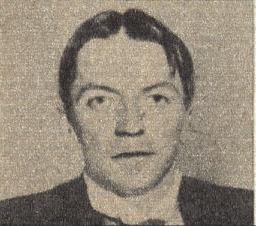Kaj Munk facts for kids
Kaj Munk (born Kaj Harald Leininger Petersen) was a Danish writer and a Lutheran pastor. He lived from January 13, 1898, to January 4, 1944. He is remembered for his strong opinions and for being killed during World War II when Denmark was occupied by Nazi Germany.
Kaj Munk is honored as a martyr (someone who dies for their beliefs) in the Lutheran Church. His special day is August 14.
Contents
Kaj Munk's Life Story
Kaj Munk was born on the island of Lolland, Denmark. After his parents died, a family named Munk raised him. From 1924 until his death, he worked as a pastor in a town called Vedersø in Western Jutland.
Most of Munk's plays became famous in the 1930s. However, he wrote many of them in the 1920s. He also wrote about big ideas like religion, Marxism, and Darwinism. These topics were often discussed in Denmark at that time.
His Views on Leaders
In the early 1930s, Kaj Munk once said he admired Adolf Hitler for uniting Germans. He even wished Denmark had a similar leader. However, his opinion quickly changed. He became disgusted with Hitler when he saw how Hitler treated Jewish people. He also disliked Benito Mussolini's actions during the war in Ethiopia.
In 1938, a Danish newspaper published a letter from Kaj Munk. In this letter, he openly criticized Mussolini for harming Jewish people.
Standing Up to Occupation
Kaj Munk strongly opposed the German occupation of Denmark (1940–1945). He did not believe in democracy, preferring the idea of a "Nordic dictator." He thought this leader could unite the Nordic countries and keep them neutral during world crises.
However, his main focus was fighting Nazism. His plays, like Han sidder ved Smeltediglen and Niels Ebbesen, directly attacked the Nazis. Niels Ebbesen was about a medieval Danish hero who killed a German occupier. This play showed how Danes felt about the German occupation during World War II.
Even though his friends told him to hide, Munk kept speaking out. He preached against Danes who worked with the Nazis.
His Death and Legacy
The Gestapo (Nazi secret police) arrested Kaj Munk on January 4, 1944. This happened a month after he preached a sermon in Copenhagen's national cathedral. He had defied a Nazi ban by doing so.
The next morning, Munk's body was found in a ditch near Silkeborg. A note was left with his body.
Kaj Munk's body was returned to his church in Vedersø. He is buried outside the church. A simple stone cross marks the spot where his body was found.
The resistance newspaper De frie Danske dedicated half of its January 1944 issue to Kaj Munk. His picture was on the front page. The paper called him "The great son of Denmark." It included parts of his New Year's sermon and details about his murder and funeral. Many important people from Scandinavia also shared their sadness and anger.
The Danish government allowed Munk's wife, Lise, to live in the parish house until she died in 1998. In 2010, the church and parish house were made into a memorial. They are now open to the public.
Kaj Munk as a Playwright
Kaj Munk often used historical events in his plays. He was inspired by famous writers like William Shakespeare and Henrik Ibsen. As a playwright, Munk was known for creating "strong characters." These characters were people who fought hard for what they believed in, whether their ideas were good or bad.
For example, in his play En Idealist, the main character is King Herod. Herod does everything to keep his power. He is only defeated when he shows kindness to the Christ child.
His Most Famous Play: Ordet
His 1925 play Ordet (meaning The Word) is often seen as his best work. It explores the idea of miracles. The play shows a family of farmers with different levels of faith. They become friends with their neighbors through a miracle.
Ordet was made into a film in 1943. Another film version in 1955, directed by Carl Theodor Dreyer, won many awards. These included the Golden Lion at the 16th Venice International Film Festival.
List of Plays
Many of Munk's plays were performed at the Royal Theatre, Copenhagen and other places. Some of his plays include:
- Pilatus (written 1917, published 1937)
- Ordet (The Word) (1925)
- Kærlighed (1926)
- En Idealist (1928)
- I Brændingen (1929)
- Kardinalen og Kongen (1929)
- Cant (1931)
- De Udvalgte (1933)
- Sejren (1936)
- Han sidder ved Smeltediglen (1938)
- Egelykke (1940)
- Niels Ebbesen (1942)
- Før Cannae (1943)
His play Niels Ebbesen was translated into English in 2007. His granddaughter, Arense Lund, and Canadian playwright Dave Carley did the translation.
See also
 In Spanish: Kaj Munk para niños
In Spanish: Kaj Munk para niños
- Clearing murder
- Schalburgtage


